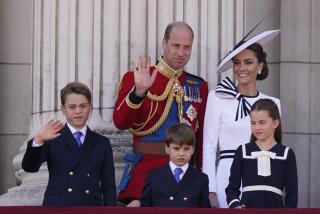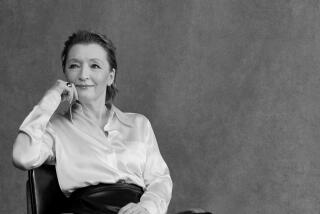Mum’s the Royal Word as Queen Mother Turns 100
- Share via
LONDON — Thanks to good genes and, perhaps, good gin, Britain’s Queen Mother celebrated her 100th birthday Friday, as tens of thousands of well-wishers turned out at Buckingham Palace to salute their favorite royal.
Tributes ranged from “Cheers Ma’am”--the headline in the Sun tabloid, which offered free coupons for the Queen Mum’s “favorite tipple”--to the traditional card that reigning Queen Elizabeth II sends to all British centenarians. Only this one, written by hand, was signed “Lilibet.”
“On your 100th birthday all the family join with me in sending you our loving best wishes for this special day,” said the message, opened with the help of a page’s sword.
The royal with a commoner’s touch, who is credited with seeing Britain through a world war, an abdication crisis and assorted House of Windsor scandals, the Queen Mother received sackfuls of birthday greetings and gifts.
Her head cocked in a powder-blue hat and her hand raised in her familiar wave, she rode in a horse-drawn carriage to Buckingham Palace with her oldest grandson, Prince Charles.
After a 41-gun salute in her honor, the royals’ grande dame appeared on the crimson-and-gold-draped palace balcony with her children, grandchildren and great-grandchildren to heartfelt cheers from the crowd.
She smiled and waved and was characteristically silent. The Queen Mother has not given an interview in 77 years, and her biographers excavate the past for meager quips to confirm her reputation as pithy and witty.
But never mind, the Queen Mum is beloved. She is a favorite grandmother, even among some of Britain’s seemingly growing number of republicans. People appreciate her taste for gin and horse racing and identify with her bank overdrafts--though those are a tad larger than the average subject’s, at a reputed $6 million-plus.
On Friday, Prime Minister Tony Blair paid tribute to her “extraordinary sense of duty,” and 75-year-old Maureen Richmond from Kent concurred.
“She has always been solid. She has principles, and she has stood by them,” Richmond said outside Buckingham Palace.
“She’s marvelous,” added Elizabeth Clifford, 29, of Lewisham, who waited with her infant daughter for four hours to see the Queen Mother.
“I’ve been brought up admiring the royal family, and she symbolizes a real foundation for us. I came here 20 years ago for her 80th birthday with my mother, so I wanted to bring my daughter with me today,” Clifford said.
British television provided live coverage of the flag-and-flower-embellished celebration. Newspapers printed pullout sections on the Queen Mother’s life and times. Porcelain statuettes, centenary cups and plates, and Queen Mum candle snuffers also were on offer to commemorate her birth in 1900.
She was born Elizabeth Bowes-Lyon to an aristocratic family in Scotland when Queen Victoria reigned over a vast British Empire, Czar Nicholas II ruled in St. Petersburg, and President McKinley occupied the White House.
The Wright Brothers had yet to get their flying machine off the ground at Kitty Hawk, N.C., and household electricity was a rarity. At the time, men in Britain could expect to live to 45 and women to 49--a norm that hardly suggested the Queen Mother would reach the ripe old age of 100.
According to the Daily Mail newspaper of Aug. 4, 1900, it was a cool and gusty natal day at a time of terrible inflation, when a clerk earning 35 shillings a week was worse off than when he had earned 28 shillings weekly the previous year.
“If you want a plum pudding next Christmas, you would do well to start saving up for it at once,” the newspaper advised. It also advertised a special sale on ladies’ flannel bathing costumes and published a letter to the editor calling for the extermination of anarchists.
The Queen Mother’s life reads like a historical atlas. Her family home in Scotland, Glamis Castle, was the setting for “Macbeth.” On her 14th birthday, Britain declared war on Germany, and her house became a makeshift hospital where she helped tend to wounded troops.
At the end of World War I, she moved into London to make her debut in society, then married the stuttering Prince Albert, younger brother of the heir to the throne, in 1923. She gave birth to the current Queen Elizabeth II three years later and to Princess Margaret in 1930.
When his brother, Edward VIII, abdicated the throne after an 11-month reign to marry the twice-divorced American Wallis Simpson, Prince Albert was crowned King George VI in 1936 and his wife became Queen Elizabeth.
The Queen Mother described Simpson, the future duchess of Windsor, as the “lowest of the low” and apparently never forgave her for damaging the reputation of the monarchy, but she set about repairing it.
King George VI was a reluctant monarch yet served dutifully with Queen Elizabeth at his side throughout World War II. Though supporters of Neville Chamberlain’s policy of appeasement, the couple nonetheless became heroes to Britons for the role they played during the London Blitz.
To suggestions that she evacuate the princesses to Canada, Queen Elizabeth said, “The children could not go without me, I could not possibly leave the king, and the king would never go.” She made speeches to Britain’s allies across the channel that were effective enough for Hitler to dub her the most dangerous woman in Europe.
Though they did not call it spin doctoring then, her aides put out the word that she was taking shooting lessons in the event she might need to protect her family from the Germans. When bombs hit Buckingham Palace in September 1940, she won the public’s affection by saying: “I am glad we have been bombed. It makes me feel I can look the East End in the face.”
Then she tiptoed through the rubble of London’s East End in high heels, talking to average folks in a way that made them feel she understood them.
Queen Elizabeth and her husband marked the end of the war in Europe on the same Buckingham Palace balcony where she appeared for her centenary Friday.
King George VI died of lung cancer in 1952 and was succeeded by his elder daughter. At 51, his widow moved down the block from Buckingham Palace to Clarence House, but she did not retire from the public eye.
As the Queen Mum, she has continued to try to set a moral tone above the collapse of her younger daughter’s and grandchildren’s marriages and to uphold a high style that she believes the people want to see in a monarch. Her staff is said to number 50, including handmaids and footmen, and she is always dressed to the nines in pastel couture and plenty of jewels.
Her indulgences and apparent excess in spending have been taken up by republicans anxious to get rid of what they say is an expensive and outdated monarchy.
“Only when you see the full monty of army, bands and royal postman do you realize what a powerful and archaic and feudal institution this is,” said Guardian newspaper columnist Jonathan Freedland. “I agree the institution is symbolic. But symbols matter, and what this symbolizes is that in this country the top job is still reserved by birthright.”
Jon Temple, spokesman for the Republic movement, observed: “The people of this country should have the right to elect their own head of state. The Queen Mother’s birthday marks the end of an era. She does have a degree of charisma her daughter doesn’t have. I think her descendants will have a problem getting a crowd out.”
They might, but the Queen Mum didn’t have any trouble at all. She thanked the estimated 40,000 celebrants outside Buckingham Palace with another wave of her 100-year-old hand, then went indoors for lunch and a birthday cake with special icing--sugar mixed with gin.
*
Janet Stobart and Kirsten Studlien of The Times’ London Bureau contributed to this report.
More to Read
Sign up for Essential California
The most important California stories and recommendations in your inbox every morning.
You may occasionally receive promotional content from the Los Angeles Times.













